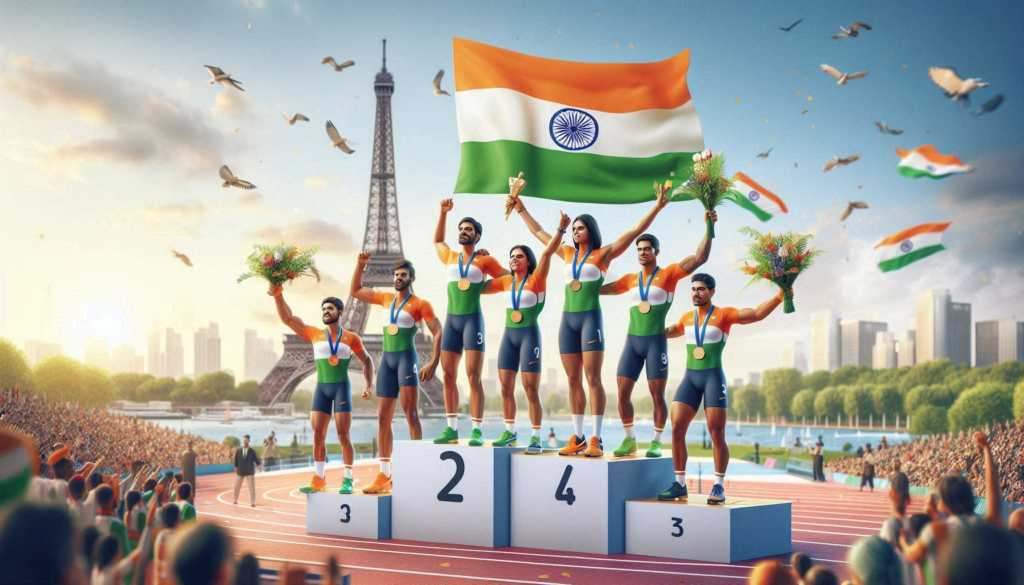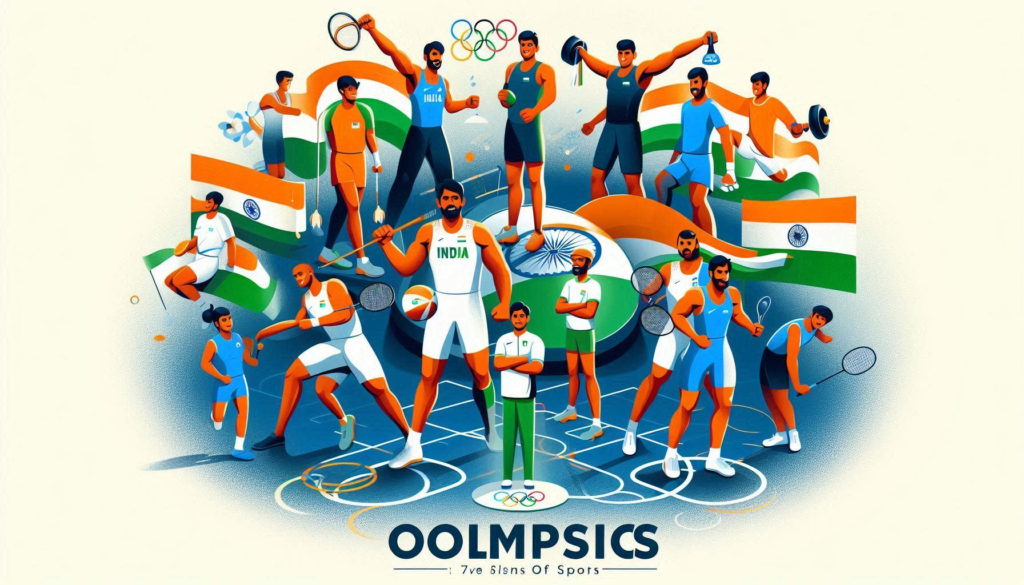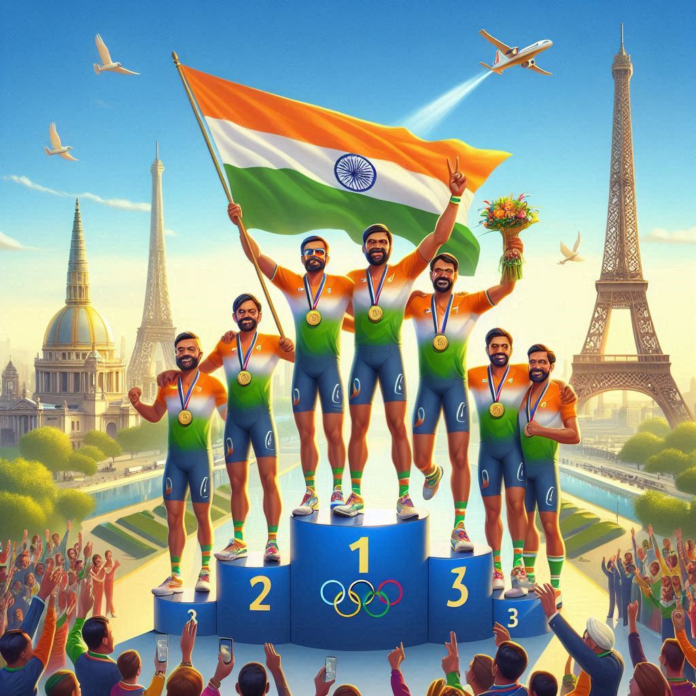India’s Olympic Journey at the Paris Olympics 2024
India’s Olympic Journey : The Paris Olympics 2024 was a significant event for India, marking a period of intense competition, high expectations, and remarkable achievements. India’s performance at the Games reflected the nation’s growing prowess in various sports, its strategic planning, and the emergence of new stars on the international stage. This detailed analysis explores how India’s campaign panned out at the Paris Olympics, highlighting key moments, medal-winning performances, challenges faced, and the overall impact on Indian sports.
Pre-Olympics Expectations and Preparations

Build-Up to the Games
India entered the Paris Olympics 2024 with a sense of optimism, following a historic performance at the Tokyo Olympics 2020 where the country secured its highest-ever medal tally of seven, including a gold in javelin throw by Neeraj Chopra. The Indian contingent for Paris was the largest ever, with athletes participating in a wide range of disciplines. The build-up to the Games was marked by rigorous training camps, international exposure through participation in global events, and the deployment of advanced sports science and technology.
The Indian government, along with the Indian Olympic Association (IOA) and various sports federations, invested heavily in athlete preparation. Targeted Olympic Podium Scheme (TOPS) provided financial support, coaching, and international exposure to elite athletes, while initiatives like Khelo India aimed to strengthen the grassroots sports ecosystem. The focus was on both traditional strongholds like shooting, wrestling, boxing, and athletics, as well as emerging sports like fencing, equestrian, and skateboarding.
Key Performances and Medals
Athletics: Continuing the Momentum
Athletics remained a cornerstone of India’s Olympic campaign, with several athletes delivering outstanding performances.

- Neeraj Chopra’s Gold Defense: Neeraj Chopra, the reigning Olympic champion in javelin throw, once again stood tall as he successfully defended his gold medal in Paris. His throw of 89.34 meters secured the top spot, making him the first Indian to win back-to-back Olympic golds. His consistency and ability to perform under pressure were widely praised, reinforcing his status as one of India’s greatest athletes.
- Annu Rani’s Breakthrough: Annu Rani, competing in the women’s javelin throw, also made history by winning a bronze medal. Her throw of 64.98 meters was a personal best and brought her on the Olympic podium, marking a significant achievement for Indian women in athletics.
- Long Jump and Triple Jump: M. Sreeshankar in men’s long jump and Aishwarya Babu in triple jump both reached the finals of their respective events. While they did not secure medals, their performances were commendable, and they gained valuable experience on the Olympic stage.
Shooting: A Mixed Bag
Shooting has traditionally been a strong area for India, and the Paris Olympics saw mixed results in this discipline.
- Gold for Divyansh Singh Panwar: Divyansh Singh Panwar, competing in the men’s 10m air rifle, clinched gold with a score of 252.4, showcasing exceptional precision and composure. His victory was a highlight for India in shooting, reaffirming the country’s dominance in air rifle events.
- Challenging Campaign for Others: However, the campaign was less successful for other shooters, with several failing to advance past the qualification rounds. This inconsistency highlighted the unpredictable nature of shooting as a sport and the need for continuous focus on mental conditioning and preparation.
Wrestling: Upholding the Legacy
Wrestling remained one of India’s most successful sports at the Paris Olympics.
- Bajrang Punia’s Bronze: Bajrang Punia, competing in the men’s 65kg freestyle category, won a bronze medal, adding to his tally of Olympic medals. His journey to the podium was challenging, with tough bouts against world-class opponents, but his resilience and tactical acumen saw him through.
- Vinesh Phogat and Reetika Hooda: Vinesh Phogat, one of India’s top wrestlers, narrowly missed out on a medal, finishing fourth in the women’s 53kg category. Reetika Hooda, a rising star, secured a bronze in the women’s 57kg category, marking her Olympic debut with a podium finish.
Boxing: Rising Stars and Tough Battles
Indian boxers entered the Paris Olympics with high hopes, given their strong performances in recent international competitions.
- Nitu Ghanghas’ Gold: Nitu Ghanghas won gold in the women’s 48kg category, displaying superb technical skills and resilience. Her victory was particularly special as it came after a series of closely contested bouts against some of the world’s best.
- Amit Panghal’s Silver: Amit Panghal, competing in the men’s 52kg category, secured a silver medal. His path to the final was marked by strong performances, but he fell short in the final bout, settling for silver.
Badminton: A Strong Showing
Badminton continued to be a strong suit for India at the Olympics.
- P.V. Sindhu’s Bronze: P.V. Sindhu, India’s star shuttler, added another Olympic medal to her collection, winning bronze in women’s singles. She continues to play at the worst best level in badminton and Saina Nehwal is easily one of India’s most successful Olympians.
- Men’s Doubles: The men’s doubles pair of Satwiksairaj Rankireddy and Chirag Shetty reached the semifinals, ultimately finishing fourth. Their performance was strong throughout the tournament, but they narrowly missed out on a medal.
Hockey: A Journey of Redemption
The Indian men’s and women’s hockey teams had contrasting campaigns in Paris.
- Men’s Team Success: The men’s hockey team, after winning bronze in Tokyo, had high expectations. Thus, they got up to the semi-finals but were beaten by the Australians. They bounced back in the bronze medal match, defeating Germany, and secured their second consecutive Olympic medal.
- Women’s Team Disappointment: The women’s hockey team, which had reached the semifinals in Tokyo, had a disappointing run in Paris, failing to progress beyond the quarterfinals. Despite strong performances in the group stages, they were unable to replicate their previous success.
Challenges and Areas for Improvement
Near Misses and Narrow Losses
While India had several successes, there were also instances of near misses and narrow losses. In disciplines like shooting and archery, several athletes were eliminated by small margins, underscoring the fine line between success and failure at the Olympics. These results highlighted the need for greater emphasis on mental toughness and consistency under pressure.
Emerging Sports and New Disciplines
India’s participation in emerging sports and new disciplines at the Paris Olympics was marked by enthusiasm but limited success. Athletes in sports like skateboarding, surfing, and sport climbing gained valuable experience, but the results were modest. The involvement in these sports indicates a broadening of India’s sporting horizons, but there is clearly a long way to go in terms of achieving competitive success.
Support Systems and Infrastructure
Despite the progress made in recent years, the Paris Olympics also underscored ongoing challenges related to sports infrastructure, coaching, and support systems in India. Athletes from certain sports still lack access to world-class facilities and coaching, which affects their ability to compete at the highest level. The need for investment in grassroots development, talent identification, and sports science remains critical.
Impact and Legacy of the Paris Olympics 2024
Boost to India’s Sporting Culture
India’s campaign at the Paris Olympics had a significant impact on the country’s sporting culture. The success stories from Paris are likely to inspire a new generation of athletes and increase participation in sports across the country. The performance in Paris has also reinforced the importance of sports as a key area of national pride and identity.
Government and Private Sector Support
The role of government initiatives like TOPS and the increasing involvement of the private sector in supporting athletes has been crucial. The Paris Olympics demonstrated the positive impact of these programs, but it also pointed to areas where further investment and support are needed. The government’s continued focus on developing sports infrastructure and providing financial support to athletes is likely to grow in the aftermath of the Games.
Long-Term Goals and Future Outlook
Looking ahead, India’s performance in Paris sets the stage for continued growth in sports. The lessons learned from the Olympics will inform future preparations, with a focus on building a stronger and more consistent presence in key sports like athletics, shooting, wrestling, and badminton. The emphasis on emerging sports will also continue, with the goal of expanding India’s medal prospects across a wider range of disciplines.
Conclusion
India’s campaign at the Paris Olympics 2024 was a blend of historic achievements, hard-fought battles, and valuable lessons. The nation’s athletes displayed courage, skill, and resilience, bringing home several medals and making the country proud. The Paris Olympics also highlighted areas where improvements are needed, particularly in terms of infrastructure, support systems, and mental conditioning.
As India continues to build on the momentum from Paris, the future looks promising for Indian sports. The success of athletes in Paris will inspire a new generation and drive further investment in sports development. With continued support, strategic planning, and a focus on excellence, India is poised to achieve even greater success in future Olympic Games and beyond.



